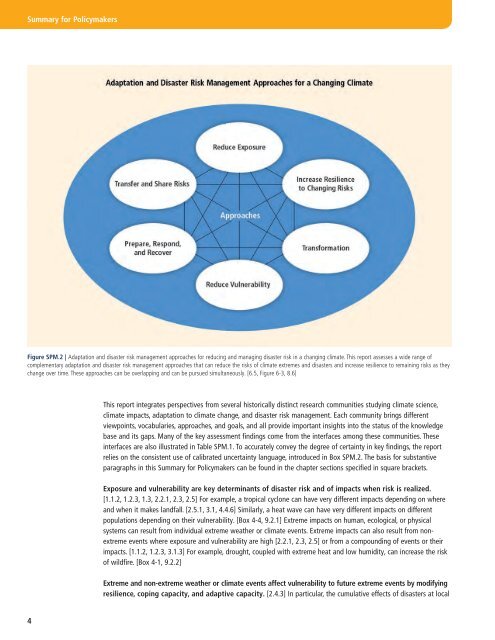Summary for Policymakers - IPCC
Summary for Policymakers - IPCC
Summary for Policymakers - IPCC
Create successful ePaper yourself
Turn your PDF publications into a flip-book with our unique Google optimized e-Paper software.
<strong>Summary</strong> <strong>for</strong> <strong>Policymakers</strong><br />
Figure SPM.2 | Adaptation and disaster risk management approaches <strong>for</strong> reducing and managing disaster risk in a changing climate. This report assesses a wide range of<br />
complementary adaptation and disaster risk management approaches that can reduce the risks of climate extremes and disasters and increase resilience to remaining risks as they<br />
change over time. These approaches can be overlapping and can be pursued simultaneously. [6.5, Figure 6-3, 8.6]<br />
This report integrates perspectives from several historically distinct research communities studying climate science,<br />
climate impacts, adaptation to climate change, and disaster risk management. Each community brings different<br />
viewpoints, vocabularies, approaches, and goals, and all provide important insights into the status of the knowledge<br />
base and its gaps. Many of the key assessment findings come from the interfaces among these communities. These<br />
interfaces are also illustrated in Table SPM.1. To accurately convey the degree of certainty in key findings, the report<br />
relies on the consistent use of calibrated uncertainty language, introduced in Box SPM.2. The basis <strong>for</strong> substantive<br />
paragraphs in this <strong>Summary</strong> <strong>for</strong> <strong>Policymakers</strong> can be found in the chapter sections specified in square brackets.<br />
Exposure and vulnerability are key determinants of disaster risk and of impacts when risk is realized.<br />
[1.1.2, 1.2.3, 1.3, 2.2.1, 2.3, 2.5] For example, a tropical cyclone can have very different impacts depending on where<br />
and when it makes landfall. [2.5.1, 3.1, 4.4.6] Similarly, a heat wave can have very different impacts on different<br />
populations depending on their vulnerability. [Box 4-4, 9.2.1] Extreme impacts on human, ecological, or physical<br />
systems can result from individual extreme weather or climate events. Extreme impacts can also result from nonextreme<br />
events where exposure and vulnerability are high [2.2.1, 2.3, 2.5] or from a compounding of events or their<br />
impacts. [1.1.2, 1.2.3, 3.1.3] For example, drought, coupled with extreme heat and low humidity, can increase the risk<br />
of wildfire. [Box 4-1, 9.2.2]<br />
Extreme and non-extreme weather or climate events affect vulnerability to future extreme events by modifying<br />
resilience, coping capacity, and adaptive capacity. [2.4.3] In particular, the cumulative effects of disasters at local<br />
4

















